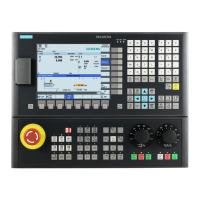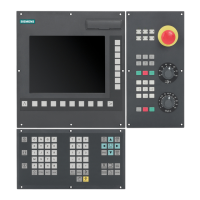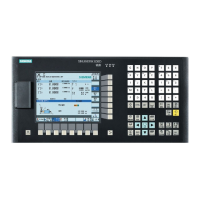H1: Manual and handwheel travel
3.6 Contour handwheel/path input using handwheel (option)
Extended Functions
Function Manual, 03/2013, 6FC5397-1BP40-3BA1
179
Traversing direction
The traversing direction depends on the direction of rotation:
● Clockwise
→ Results in travel in the programmed direction
If the block-change criterion (IPO end) is reached, the program advances to the next
block (response identical to
G60).
● Counterclockwise
→ Results in travel in the programmed direction
Here, the axes can only traverse to the appropriate block start. Pulses are not collected if
the handwheel continues to rotate.
Activation of the function
The function can be activated via interface signals or via the NC program:
● Activation via interface signal
Switching-in/switching-out is realized via the interface signal:
DB21, ... DBX30.0-2 (activate contour handwheel (1, 2, 3))
● Activation via the NC program
The contour handwheel can be activated in the NC program non-modally using
FD=0, that
is, velocity
F... from the block before the contour handwheel applies in the following
block without the need for additional programming.
Note
If no feedrate was programmed in the previous blocks, a corresponding alarm is output.
FD and F cannot appear in the same NC block (triggers an alarm).
Contour-handwheel simulation
When the contour handwheel is activated, it can also be simulated.
After activation via interface signal
DB21, ... DBX30.3 (contour-handwheel simulation),
the feedrate is no longer defined by the contour handwheel; the programmed feedrate is
used instead.
The direction is also defined via an interface signal:
DB21, ... DBX30.4 (negative direction simulation contour handwheel)
When the simulation is deselected or the direction is changed, the current movement is
decelerated using a braking ramp.
Note
The override is effective as for NC-program execution.

